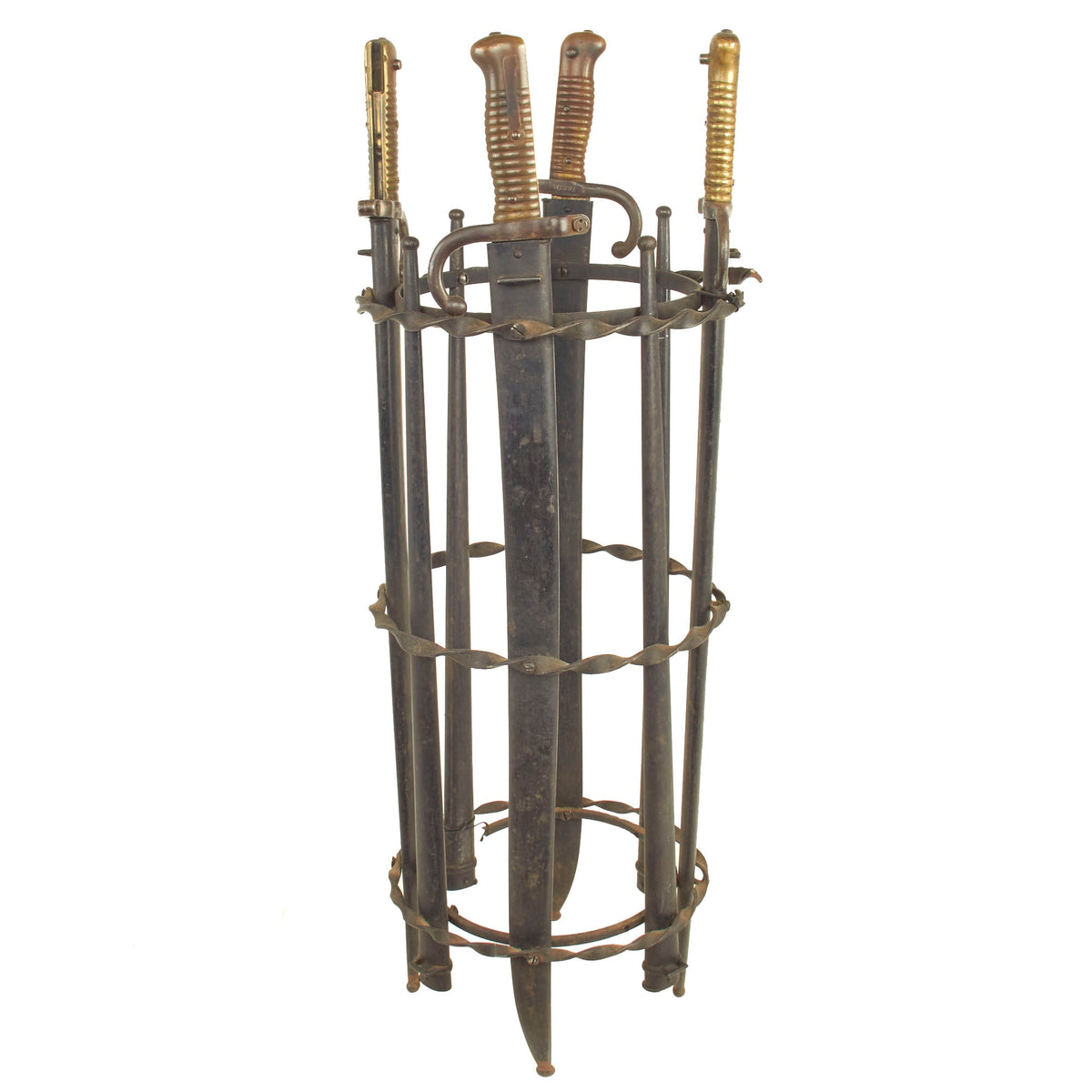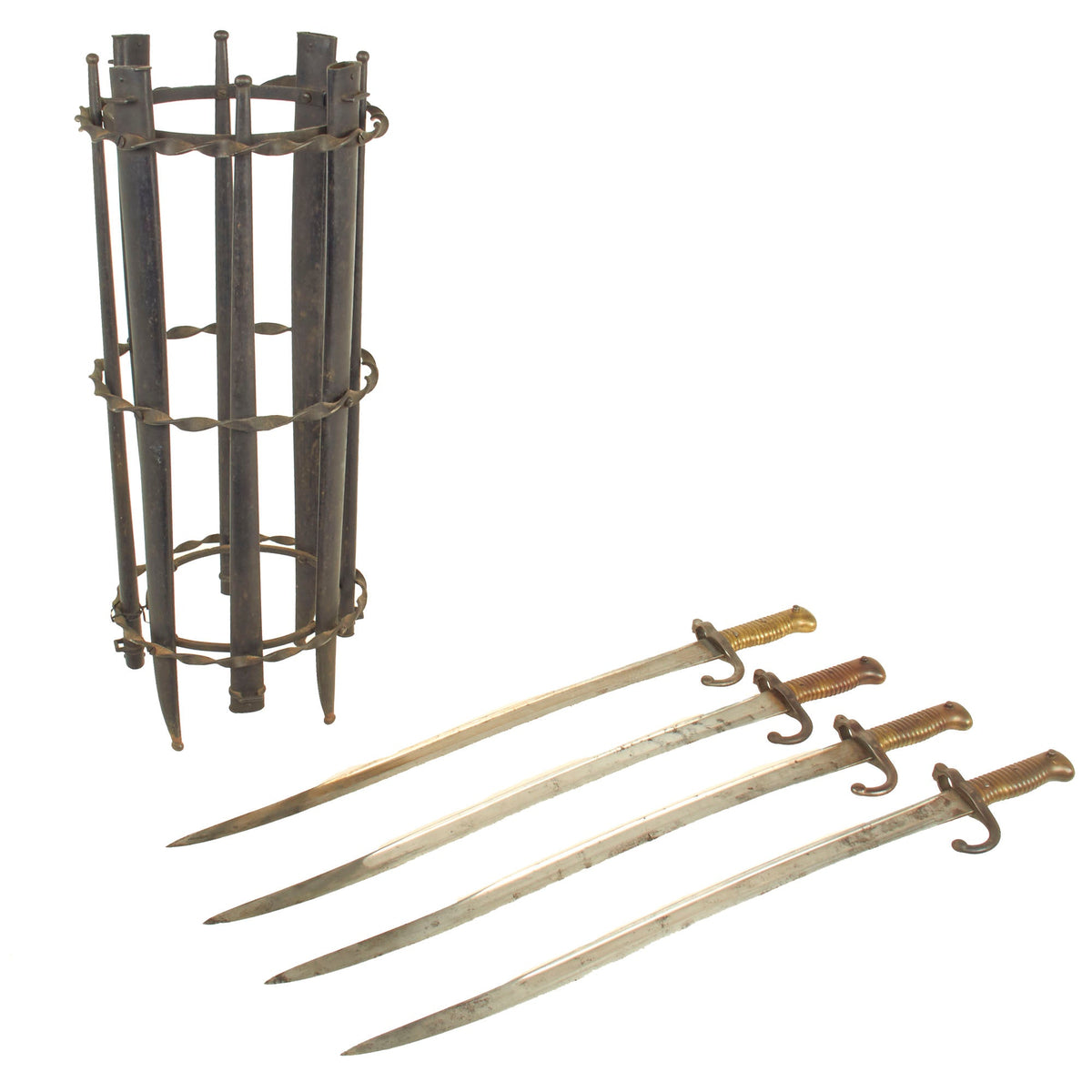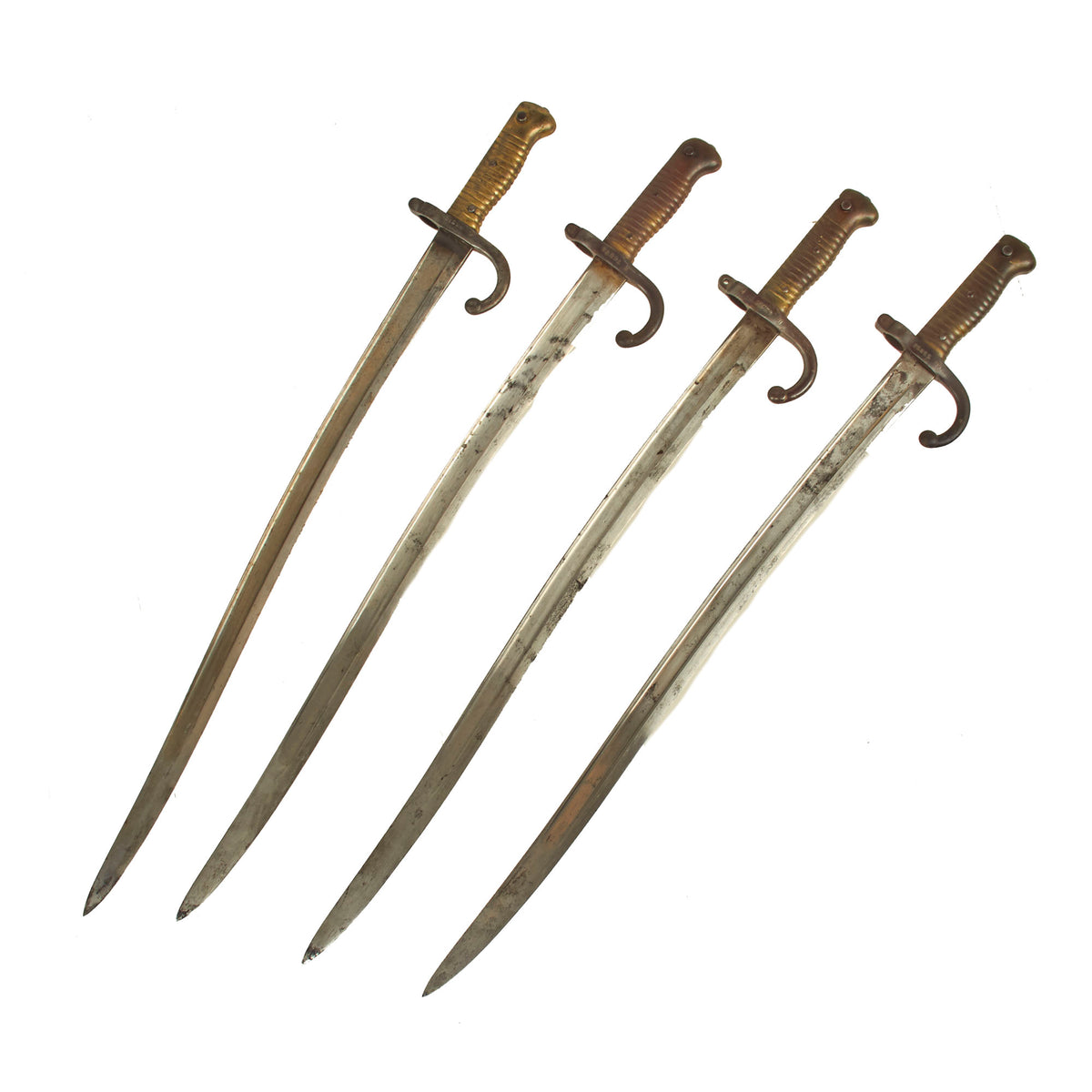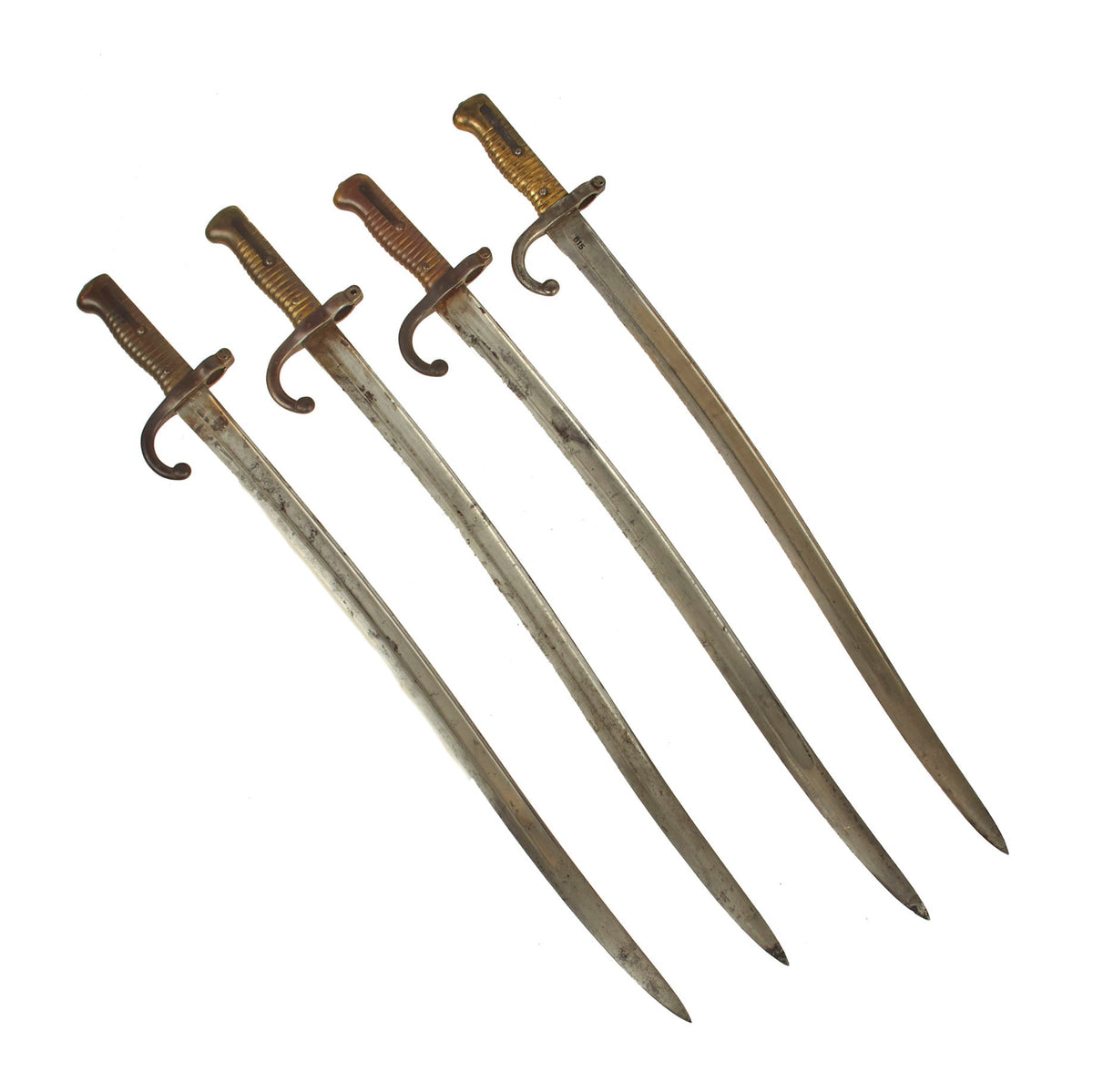Original Custom Umbrella Basket Made With Four French M1866 Bayonets in Scabbards and Gras Bayonet Scabbards Original Items
$ 595,00 $ 178,50
Original Items: One of a Kind Set. Here we have just what any 19th Century French military collector needs! This is a lovely custom umbrella basket, made using four French M1866 Chassepot Bayonets, with four M1874 Gras Bayonet scabbards spaced between them. They are held together using two iron hoops on the interior, with 3 twisted wrought iron hoops on the exterior. Overall the umbrella basket measures 10 1/2″W x 28″H, and really looks great!
Additionally, all four of the bayonets are actually still intact, as the screws holding it together only attach to the scabbards. They can be removed from the scabbards, and most even still have visible original markings! Condition is very good, showing a lovely oxidized patina on a lot of the metalwork, where the original black paint has flaked away. There are also some cracks in outer hoops where the screws go through, which could be repaired. One is held in place by a zip tie presently.
Just the thing to keep by the door to deter people with ill intentions!
Specifications (Bayonets):
Blade Length: 22 3/4″
Single Edge “Yataghan” w/ Fuller
Overall length: 27 1/2“
Crossguard: 4”
Scabbard Length: 23″
The Chassepot bayonet was the first of the French saber bayonets to have
a hooked quillion. This design feature was quite popular in the late 19th Century, when the bayonet was considered a form of fencing. When parrying the enemy’s thrust, the soldier was to use his own bayonet to deflect the enemy blade and the quillion – like the quillion on a sword – was intended to keep the enemy’s blade from continuing downward; in this case sliding down the length of the rifle to strike the soldier’s left arm and hand holding the forestock of his rifle.
Chassepot
The Chassepot, officially known as Fusil modèle 1866, was a bolt-action military breechloading rifle. It is famous for having been the arm of the French forces in the Franco-Prussian War of 1870–1871. It replaced an assortment of Minié muzzleloading rifles, many of which were converted in 1864 to breech loading (the Tabatière rifles). An improvement to existing military rifles in 1866, the Chassepot marked the commencement of the era of modern bolt action, breech-loading military rifles. The Gras rifle was an adaption of the Chassepot designed to fire metallic cartridges introduced in 1874.
It was manufactured by Manufacture d’armes de Saint-Étienne (MAS), Manufacture d’Armes de Châtellerault (MAC), Manufacture d’Armes de Tulle (MAT) and, until 1870, in the Manufacture d’Armes de Mutzig in the former Château des Rohan. Many were also manufactured under contract in England (the “Potts et Hunts” Chassepots delivered to the French Navy), in Belgium (Liege), and in Italy at Brescia (by Glisenti). The approximate number of Chassepot rifles available to the French Army in July 1870 was 1,037,555 units. Additionally, state manufacturies could deliver 30,000 new rifles monthly. Gun manufacturers in England and Austria also produced Chassepot rifles to support the French war effort. The Steyr armory in Austria delivered 12,000 Chassepot carbines and 100,000 parts to France in 1871. Manufacturing of the Chassepot rifle ended in February 1875, four years after the end of the Franco-Prussian War, with approximately 700,000 more Chassepot rifles made between September 1871 and July 1874.
The French Fusil “Gras” Modèle 1874 Rifle had a caliber of 11mm and used black powder centerfire cartridges that weighed 25 grams. It was a robust and hard-hitting weapon, but it had no magazine and so could only fire one shot after loading. It also had a triangular-shaped sword bayonet, known as the Model 1874 “Gras” sword bayonet. It was replaced by the Lebel rifle in 1886, the first rifle to use smokeless gunpowder. In the meantime, about 400,000 Gras rifles had been manufactured.
The metallic-cartridge Gras was manufactured in response to the development of the metallic cartridge designed by Colonel Boxer in 1866 (Boxer cartridge), and the British 1870 Martini-Henry rifle. Those were soon emulated by the Germans with the 1871 Mauser.
The Hellenic Army adopted the Gras in 1877, and it was used in all conflicts up until the Second World War. It became the favourite weapon of Greek guerrilla fighters, from the various revolts against the Ottoman Empire to the resistance against the Axis, acquiring legendary status. The name entered the Greek language, and grades (γκράδες) was a term colloquially applied to all rifles during the first half of the 20th century. It was manufactured by various arms factories in France, though most of the rifles sent to Greece were made by the ŒWG Austrian Arms Factory at Steyr.
NOTE: International orders of antique firearms MUST be shipped using UPS WW Services (courier). USPS Priority Mail international will not accept these. International customers should always consult their country’s antique gun laws prior to ordering.
Fast Shipping with Professional Packaging
Thanks to our longstanding association with UPS FedEx DHL, and other major international carriers, we are able to provide a range of shipping options. Our warehouse staff is expertly trained and will wrap your products according to our exact and precise specifications. Prior to shipping, your goods will be thoroughly examined and securely secured. We ship to thousands clients each day across multiple countries. This shows how we're dedicated to be the largest retailer on the internet. Warehouses and distribution centres can be located throughout Europe as well as the USA.
Note: Orders with more than one item will be assigned a processing date depending on the item.
Before shipping before shipping, we'll conduct a thorough inspection of the items you have ordered. Today, the majority of orders will be delivered within 48 hours. The delivery time will be between 3-7 days.
Returns
The stock is dynamic and we cannot completely manage it because multiple stakeholders are involved, including our factory and warehouse. So the actual stock may alter at any time. It's possible that you may not receive your order once the order has been made.
Our policy is valid for a period of 30 days. If you don't receive the product within 30 days, we are not able to issue a refund or an exchange.
You can only return an item if it is unused and in the same state as the day you received it. You must have the item in its original packaging.
Related products
Uncategorized
Uncategorized
Uncategorized
Uncategorized
Uncategorized
Uncategorized
Uncategorized
Australian WWII Owen MK1 Machine Carbine SMG Custom Fabricated Replica with Sling Original Items
Uncategorized
Uncategorized
Uncategorized
Band of Brothers ORIGINAL GERMAN WWII Le. F.H. 18 10.5cm ARTILLERY PIECE Original Items
Uncategorized
Angolan Rebel 1970s era 60mm Inert Display Mortar from Angolan Civil War Original Items
Uncategorized
Uncategorized
Uncategorized
Uncategorized
Uncategorized
Uncategorized













































































